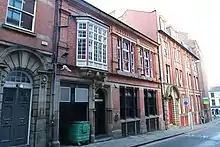
Shops on Heathcote Street, Nottingham 1882

20 Fletcher Gate, Nottingham, 1883

25 Warser Gate, Nottingham 1890–91
William Henry Booker FRHistS (23 January 1826 – 10 March 1896) was an English architect based in Nottingham.[1]
He was born in Sneinton, Nottingham on 23 January 1826, the son of William Booker (architect and surveyor) and Eliza (d. 1884). He entered into partnership with his two younger brothers, Frederick Richard Booker (1827–1882) and Robert Booker and they worked from office on Short Hill, Nottingham as W & F. R Booker, and later W & F & R Booker.
He married Sarah (d. 17 May 1878[2]).
In 1876 he was elected a Fellow of the Royal Historical Society in London.[3]
He died on 10 March 1896[4] at Nottingham.
Notable works
- Baptist Chapel, Lenton 1856–57
- Baptist Chapel, Queen Street, Ilkeston 1857-58[5]
- 54a High Pavement, Nottingham[6] with Robert Booker
- Lace Factory, 63–67 Mansfield Road, Nottingham[7] 1881–82[8] (extension)
- Shops on Heathcote Street, Nottingham 1882[9] with Robert Booker and Frederic William Booker
- Warehouse, Riste’s Place/Barker Gate, Nottingham 1883[10] with Robert Booker
- 20 Fletcher Gate, Nottingham 1883[11] with Robert Booker
- 18 Fletcher Gate, Nottingham 1885[12] with Robert Booker
- Flying Horse Inn, Poultry, Nottingham 1875 (west gables)[13] with Robert Booker
- Housing in streets surrounding St. Stephen's Church, Sneinton, Nottingham 1888 onwards[14] with Robert Booker
- Warehouse, 25 Warser Gate, Nottingham 1890–91[15] with Robert Booker and Frederic William Booker
- 15 Commerce Square, Nottingham 1897–98[16] with Robert Booker and Frederic William Booker
References
- ↑ Brodie, Antonia (20 December 2001). Directory of British Architects 1834–1914: Vol 1 (A–K). Royal Institute of British Architects. p. 219. ISBN 0826455131.
- ↑ "Deaths". Nottinghamshire Guardian. England. 24 May 1878. Retrieved 3 February 2019 – via British Newspaper Archive.
- ↑ "Mr. W.H. Booker". Nottingham Journal. England. 29 January 1876. Retrieved 3 February 2019 – via British Newspaper Archive.
- ↑ "Deaths". Nottinghamshire Guardian. England. 14 March 1896. Retrieved 3 February 2019 – via British Newspaper Archive.
- ↑ Historic England. "Baptist Chapel (1329209)". National Heritage List for England. Retrieved 3 February 2019.
- ↑ Harwood, Elain (2008). Pevsner Architectural Guides. Nottingham. Yale University Press. p. 102. ISBN 9780300126662.
- ↑ Historic England. "Lace Factory (1058996)". National Heritage List for England. Retrieved 3 February 2019.
- ↑ Harwood, Elain (2008). Pevsner Architectural Guides. Nottingham. Yale University Press. p. 139. ISBN 9780300126662.
- ↑ Harwood, Elain (2008). Pevsner Architectural Guides. Nottingham. Yale University Press. p. 113. ISBN 9780300126662.
- ↑ Harwood, Elain (2008). Pevsner Architectural Guides. Nottingham. Yale University Press. p. 110. ISBN 9780300126662.
- ↑ Harwood, Elain (2008). Pevsner Architectural Guides. Nottingham. Yale University Press. p. 92. ISBN 9780300126662.
- ↑ Harwood, Elain (2008). Pevsner Architectural Guides. Nottingham. Yale University Press. p. 92. ISBN 9780300126662.
- ↑ Harwood, Elain (2008). Pevsner Architectural Guides. Nottingham. Yale University Press. p. 77. ISBN 9780300126662.
- ↑ Harwood, Elain (2008). Pevsner Architectural Guides. Nottingham. Yale University Press. p. 152. ISBN 9780300126662.
- ↑ Historic England. "25 Warser Gate (1270401)". National Heritage List for England. Retrieved 3 February 2019.
- ↑ Harwood, Elain (2008). Pevsner Architectural Guides. Nottingham. Yale University Press. p. 102. ISBN 9780300126662.
This article is issued from Wikipedia. The text is licensed under Creative Commons - Attribution - Sharealike. Additional terms may apply for the media files.